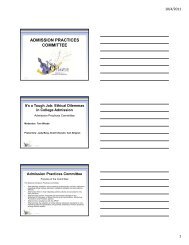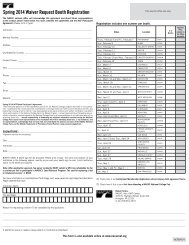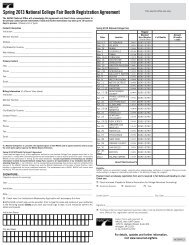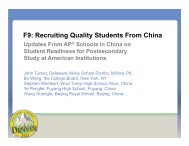Summary of NACAC/U.S. News & World Report Ad Hoc Committee ...
Summary of NACAC/U.S. News & World Report Ad Hoc Committee ...
Summary of NACAC/U.S. News & World Report Ad Hoc Committee ...
You also want an ePaper? Increase the reach of your titles
YUMPU automatically turns print PDFs into web optimized ePapers that Google loves.
preliminary results were available to committee members. Among discussion points<br />
were:<br />
- Further analysis <strong>of</strong> survey results for committee and for public<br />
- Reliance on rankings by international students<br />
- Concerns with the emphasis <strong>of</strong> the peer assessment survey<br />
- Effects <strong>of</strong> methodology on data reporting on colleges and other organizations;<br />
desire to allow individuals to organize the ranking data themselves based on their<br />
own weights/preferences<br />
� USNWR discussed the presence <strong>of</strong> multiple college data publishers who are publishing<br />
much <strong>of</strong> some <strong>of</strong> the same basic non-ranking college data that U.S. <strong>News</strong> is publishing,<br />
existence <strong>of</strong> other rankings, and demand for information in the marketplace; noted<br />
existence <strong>of</strong> large amounts <strong>of</strong> data, and that the value-added is from organizing and<br />
making sense <strong>of</strong> it for consumers<br />
� USNWR discussed changes in the media industry that have affected print publications,<br />
including magazines, with a resulting shift toward digital content<br />
� <strong>Committee</strong> will release data from survey throughout the fall, culminating in a survey<br />
report in December 2010/January 2011<br />
� <strong>NACAC</strong> committee members noted that some <strong>of</strong> the member survey is predictable,<br />
some is contradictory; for example, survey results suggest that members think rankings<br />
encourages counter-productive behavior, but few identified their own institution as the<br />
source <strong>of</strong> such behavior<br />
IV. Discussion <strong>of</strong> recent changes to US <strong>News</strong> rankings methodology, publication<br />
� <strong>NACAC</strong> committee members drew attention to the peer assessment portion <strong>of</strong> the<br />
methodology—member survey indicated the most member concern about methodology<br />
focused on peer assessments<br />
� USNWR has reduced the weight <strong>of</strong> the academic peer survey in the National<br />
Universities and National Liberal Arts categories in the current year’s methodology<br />
(published 8/17/10) by 10 percentage points.<br />
� Questions about organization <strong>of</strong> the U.S. <strong>News</strong> ranking by Carnegie Classifications were<br />
raised; USNWR had discussed internally and with many in higher education over the<br />
years that its old names <strong>of</strong> categories were not self-evident to some users. As a result,<br />
the ranking category names were changed on 8/17/10. UNEWS felt that the new<br />
categories have become significantly better than in previous years based on recent<br />
feedback by colleges; <strong>NACAC</strong> members noted that there are still categories that<br />
combine colleges that are substantially dissimilar<br />
<strong>NACAC</strong>/US <strong>News</strong> <strong>Ad</strong> <strong>Hoc</strong> <strong>Committee</strong>_Public <strong>Summary</strong> <strong>of</strong> 9/30/2010 meeting Page 2 <strong>of</strong> 3










